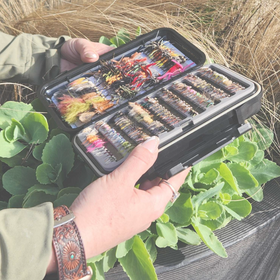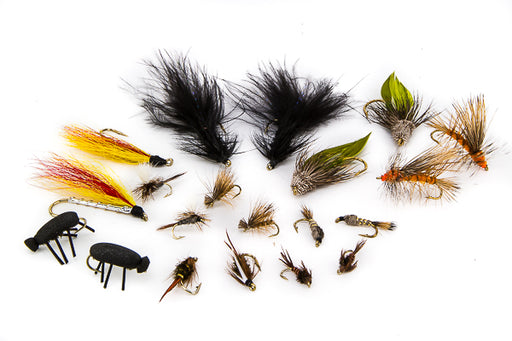
Setting Up A Nympg Rig for Steelhead
Catching a steelhead is about the funnest thing one can do with a fishing rod, and using a nymph setup is arguably the most effective way to do it. There are a ton of ways to set up a nymph rig for steelhead. Here are a couple of basic methods for setting up a nymph rig. We are using some local methods, names and products that are popular here in our little piece of the world. We do realize that there are likely dozens of other names for these methods.
Tapered Leader: The most basic method is essentially the same way most anglers rig up to nymph for trout, but maybe a bit heavier. This is the easiest one to do for a beginner as it is simple to grab a steelhead leader and then you can be fishing with little second guessing. This method starts with (usually) a 9' tapered steelhead leader. Steelhead leaders are more stout than a trout leader, which makes them a better choice for throwing these bigger setups.

This is an easy rig to use and to get you started in the nymph game
Locals here tend to prefer a 12#, 9' leader to start. An indicator will go near the top of the leader anywhere from 3 feet to right next to the fly line. A blood knot (or your preferred knot) is added to 2-3' of strong tippet. Then two flies are added to the tippet. We will cover fly options below. Typically, split shot is added above the knot that connects the tippet to the leader. Split shot is also covered below.
The Klickitat Method: Most of the guiding for steelhead is done from a drift boat on the Klickitat and those guides have this method down to a science. There are a couple of guides on that river that are just 100% dialed in and this is how the ones I know like to rig us, and it is the preferred method for shop employees.
From the fly line, add a 4-5' section of a stiff 20# or 25# monofilament with a loop on the fly line end. We see a lot of anglers here using Maxima Chameleon for that, but any other stiff mono with a thick diameter should be ok.

This is the rig that most of the top local guides are using
The second section is often 15# Maxima Ultragreen, which is super strong, but not as stiff as chameleon. This 2-3' section is connected to the first section with a knot (blood knot or similar). A small loop is added to the bottom of the 15# section. I prefer a non-slip mono loop knot. Anglers tend to add the split shot above the knot. Some anglers crimp it onto the loop so that there are two pieces of line for the split shot to hold onto.
A section of tippet is then looped onto the 15# maxima with whatever flies or beads you like. A couple of guides I know do not use a loop on the tippet end, they just tie the tippet directly to the loop with a standard clinch knot. This method is great for a couple of reasons. The first is that the heavy material will turn over big rigs with split shot. The second reason is that it is quick and easy to tie on a new set of flies. Since you are using loop-to-loop connections on the leader, you can tie up dropper rigs at home and then loop them on quickly on the river without having to tie many (if any) knots.
You could easily use a tippet ring instead of the loops between leader and tippet, but that hasn't really caught on with the steelhead crowd here yet. I recently tried it, but quickly dropped the tippet ring in the river. I gave up and went back to a loop setup before I could give it another chance.

This steelie was caught on a glo-bug, Blue Method
The Blue Method: Blue is an infamous guide around here and he spent a year or two showing me his methods when I first moved here as we fished together throughout the area. This is how he sets up and how I prefer to nymph from the boat.
He likes to keep his fishing setups simple. No need for extra knots, tippet spools or anything else. This method uses a straight 6' section of 12# Maxima Ultragreen from the fly line to the fly. He crimps down about 4 split shot about 1' above the flies. The beauty of this method is the simplicity. You can fish all day with minimal knots, one spool of tippet and very little time rigging up. Its short, which makes the casting easier, less tangling up, less mess to deal with.
For Blue, the indicator is completely optional. He is pretty fishy though. I think most steelhead anglers prefer the indicators because the soft takes that these big fish can produce are hard to detect without the indicator.
This method seems too simple to work well. Anglers like to overthink things. This can lead to really overly complicated rigs. There are not a lot of guides around here more infamous than Blue, and fewer that catch more fish than him or his clients. I have seen him outfish me using this simple method more than one time.

The Blue Method is simple and effective
The Flies

Eggs, Stoneflies and Leeches
You can arguably use just about anything for a steelhead fly. They are (typically) not actively feeding and they tend to hit flies because of aggression and/or opportunity from my experience. The most popular types of steelhead flies are:
A) egg patterns
The terms are quite loose as many of these patterns do not look much like the actual thing they claim to represent. Stonefly patterns are big, buggy patterns and leech patterns are often brightly colored marabou or bunny flies...

Popsicle is a "leech" pattern
One of my best friends is a gear guide on the Olympic Peninsula and he always reminds me that his best steelhead lure is a small piece of yarn snelled onto a hook. He constantly yells: "yarn on a hook, it's all you need!"...
Most steelhead nymph anglers will use two "flies". The local preferred method is to use at least one egg bead in the setup, typically as the trailer or dropper fly. Using a Trout Bead is a game changer and accounts for most of the steelhead hooked on nymph setups around here. An 8mm peachy king is the go-to bead locally.
Bead Rig
The bead rig is typically used under another fly like a stonefly or leech pattern, although many anglers will go with 2 bead rigs together. Here is a video on setting up a bead rig
Split shot

I have used up to 6 split shot in a run, but 3 is more realistic. You need to be near the bottom, but not dragging the bottom. I tend to add them until I consistently hit bottom and then take one or two off. Adding and removing shot can make all the difference if you are in a spot where you know the fish are and you aren't sure if you are getting to them. I do it before adjusting the indicator.
Leaders and Tippet

The Local's Choice
As you may have noticed, Maxima Ultragreen is by far the preferred material for leader and tippet around here. It is a local Oregon company, which may be part of the reason. Otherwise, it is because it is very strong, has the right amount of stiffness, is easy to work with and widely available. Even though I work here, I have had to buy a spool at about just every gas station in a 3 county area at some point.
RIO makes a very similar tippet material, which boasts all of the same qualities that Maxima does. It is very similar and quite popular outside of the local area here, as we ship a lot of it, but don't sell a ton in the showroom. I would happily fish it as it does look and feel quite strong.
Scientific Angler's Absolute Mono is also quite acceptable for steelhead fishing. Their material is always strong, it's plenty stiff, plus the built-in cutter and the silicon band make it a top choice if you are in the market. The big difference is that the break strengths don't match RIO or Maxima for the equivalent diameter. The 12# Maxima we like has a diameter of .013". (RIO's 12# test is .014"diameter). The equivalent .013" diameter of S/A tippet is boasting 20# break strength. So, yes, I would go with their 20# for steelhead fishing with this tippet.
Indicators
Air-locks and Thingamabobbers are the most popular and effective indicators for steelhead because they hold up more weight than other styles. Most situations can be fished with a 3/4" indicator, but it gets a little dicey with 4 AB split shot and a weighted nymph. I keep a few 1" indicators around just in case the 3/4" can't handle it.
One thing I remember being taught early on is that your indicator does not have to be on top of the water to work. As long as you can see it and your drift is good, then the indicator works. There are a couple of swirly holes here that will pull most indicators under, bur you just have to let it ride.... another thing to consider.

This run requires a lot of weight to get down
Indicator Placement
From my experience, the zone is typically around 6 feet from indicator to split shot, although going down to 4 feet and up to 9 feet is not unusual. That means that methods like the tapered leader may require moving the indicator down the leader 3 feet or more, or even placing it 3' down as the baseline...
That is also why it is nice to use the stiff leaders and tippet materials instead of the more limp trout leader material.
Most anglers try to make the depth of their rig about 1.5x the depth of the water they are fishing, but there are a lot of factors that may change that. I want my fly to get down quicker in fast water, but the overall depth will be shorter as the line is more straight up and down with more weight... Moving the indicator and changing the split shot should be able to get the flies into the zone in most situations. It is a matter of figuring out where that zone is and what you need to do to get into it...

These are tough critters to catch. They run in small numbers and can move through a system really quickly. Or they might show up in a big pod and sit in the same pool for three months...
There are literally countless ways to catch a steelhead. This includes rigging up a nymph rod for steelhead. If there is a method that works for you, by all means, keep doing it. Steelhead are mysterious creatures. You can catch them deep, shallow, in fast water, slow water, dirty water and clean. And a lot of the time or not at all... We just wanted to share the effective methods that we use around the area here where we fish. Thank you for reading.









